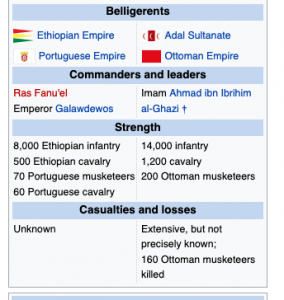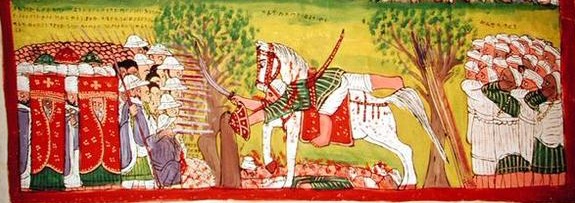In 1543 CE, of course the Spanish depradations in the “New World” continued. Back home in Seville, King Charles V may, the previous year, have signed the “New Laws” that sought to restrain the violence the conquistadores/settlers used against the indigenes. But over there (here) in the Americas, the settlers and their military bosses paid no heed, mocking the “New Laws”.
In the history of the emergence of Western domination of the world order, the Spanish conquista continued to form easily the narrative’s main strand. But in 1543, other European empires and proto-empires were also seeing significant developments:
 In February, in the Ethiopian highlands, the Portuguese-Ethiopian joint force that had been defeated in August 1542 made a spectacular comeback against their Ottoman-backed “Adal Sultanate” foes, defeating them at the Battle of Wayna Daga. The Portuguese/Ethiopian fighters managed to kill Adal military leader Imam Ahmad and upon learning of his death his forces scattered. The Portuguese and Ottomans would continue to clash in and around the Arabian Sea, but for now the Portuguese had won a clear victory. (The banner above is a painting of the death of Imam Ahmad by Kehneta Jemlieri Hailu, c. 1900 CE.)
In February, in the Ethiopian highlands, the Portuguese-Ethiopian joint force that had been defeated in August 1542 made a spectacular comeback against their Ottoman-backed “Adal Sultanate” foes, defeating them at the Battle of Wayna Daga. The Portuguese/Ethiopian fighters managed to kill Adal military leader Imam Ahmad and upon learning of his death his forces scattered. The Portuguese and Ottomans would continue to clash in and around the Arabian Sea, but for now the Portuguese had won a clear victory. (The banner above is a painting of the death of Imam Ahmad by Kehneta Jemlieri Hailu, c. 1900 CE.)- 1543 saw significant steps by England’s Henry VIII to consolidate the rule of his lineage over as much of geographical “Britain” as possible. Henry’s parliament consolidated the union with Wales. Henry signed a treaty with Scotland. The Scottish parliament repudiated that one– and indeed, in 1543, the infant Mary Suart was crowned “Queen of Scots”, in Stirling. (Union with Scotland would take the English a long while to achieve.) In 1543, Henry’s Parliament also signed an Act of Succession that restored his daughters Mary and Elizabeth to the succession along with his his still-young son Edward.
- In Central Europe, the Ottoman military advanced further into Hungary, taking the cities of Esztergom and of Székesfehérvár. And in the Western Mediterranean, the joint Ottoman-French naval force completed the capture of Nice (that I’d prefigured in yesterday’s post.)
- The first Portuguese ship that landed in Japan, in 1542, had apparently been blown off course and landed there by accident. But in 1543, the famous Chinese pirate Wang Zhi worked with some of the Portuguese marine adventurers active in the region to bring a shipment of Portuguese matchlocks to the lord of Tanegashima, a Japanese island southeast of Kyushu. The lord was intrigued. He immediately set about replicating them, which increased demand for the saltpeter that was an essential ingredient of gunpowder. (Wang Zhi, as it happened, could also help him get hold of that…)
- In 1543, Martin Luther published his antisemitic screed On the Jews and their Lies.
